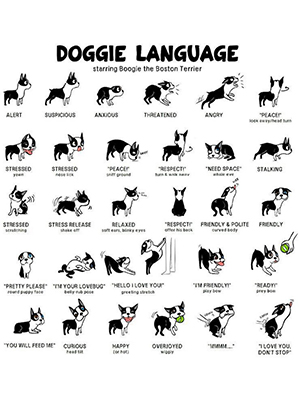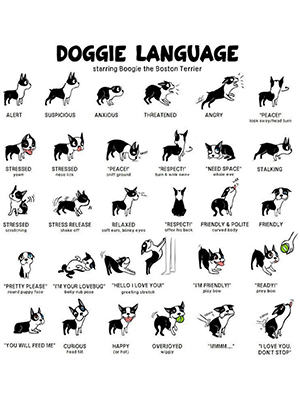How to Read a Dog’s Body Language
 Did you know that all dogs can talk? They may not be able to use words, but our canine companions can express a wide range of emotions and actions by communicating with their bodies. While we can’t sit down and chat with our dogs just yet, we can learn how to recognize and interpret dog body language to better understand what any dog may be telling us.
Did you know that all dogs can talk? They may not be able to use words, but our canine companions can express a wide range of emotions and actions by communicating with their bodies. While we can’t sit down and chat with our dogs just yet, we can learn how to recognize and interpret dog body language to better understand what any dog may be telling us.
To ‘read’ a dog, you must look at all the separate physical cues together to size up what the entire dog’s body language is saying. Here are some head-to-tail signs to note when meeting any new dog.
The Language of a Dog’s Ears
Dog ears come in all shapes and sizes, allowing some dogs to better communicate with them than others. Calm, contented dogs tend to relax their ears in a position that is natural to them. When alert, or if feeling aggressive or dominant, a dog will raise their erect/tense ears higher on their head and point them at the direction of their interest. If a dog has their ears pulled flat against their head, the dog is likely fearful, worried or submissive.
The Language of a Dog’s Eyes
Like people, a dog’s eyes can tell you a lot about how they are feeling. A content dog will look at you with a relaxed expression or ‘soft eyes,’ while direct staring indicates a dog might feel threatened or want to assert dominance. If a dog averts their gaze, they want to show submission, as they may be worried about interacting with you. Large, dilated pupils, or when a dog looks at you from the corner of their eyes, usually prelude aggressive or fear-based behavior.
The Language of a Dog’s Mouth
A dog’s mouth mimics the emotions human mouths show. A relaxed dog will have a soft, relaxed mouth, which may look like a grin. If a dog has a tight mouth or tensed-up lips, that shows tension. A curled lip and exposed teeth may be signs of aggression, but some breeds (like Chesapeake Bay Retrievers) do this as a smile. Tongue flicking or licking often indicates uncertainty or uneasiness, and yawning helps lower a dog’s blood pressure and calms them.
A Dog’s Body Language
Muscle tension is your guide to the emotions being conveyed by a dog. Tight muscles, especially around the head and shoulders, often indicate a dog who is scared or aggressive. Fur can also clue people in on how a dog is feeling. Calm dogs will display a smooth coat along their back, while scared or challenged dogs will raise the hairs (called hackles) along their neck and back to appear larger in size.
The Language of a Dog’s Tail
Tail position and movement are big indicators of dog emotions. Excited dogs hold their tails high and wag them quickly from side to side. A cautious or nervous dog will also wag their tail, but it will be straight out and wagged slower and more steadily. When alert, a dog holds their tail tall and erect, while a fearful dog will tuck the tail between the legs. A content dog keeps their tail relaxed in a position natural to them, because like dog ears, no two dog tails are alike.
These guidelines are a general overview of dog body language, and the signals and their meanings can vary between breeds. When in doubt, accept the most fearful or aggressive signal a dog is showing you. If the tail is wagging, but the dog is grimacing and looks tense, assume the most dangerous end is telling the truth. Your goal is to observe the entire dog, and the situation and context the animal is in, and do your best to accurately determine what the dog is trying to say. With time and education, you’ll soon speak another language — with man’s best friend!
If you love dogs and want some hands-on training in canine body language, volunteer with The Animal Foundation!

